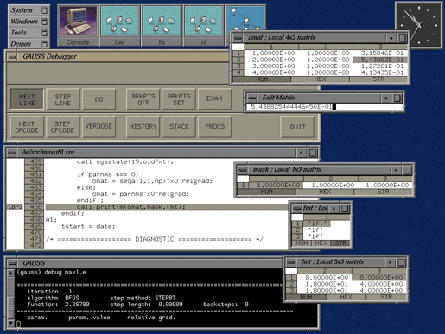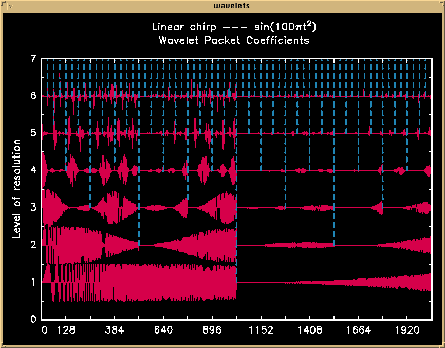|
|
|
 |
|
|
| GAUSS |
|
どのような数学ツール、あるいはランゲージを現在使用していても、GAUSS を使用することにより、生産性を大幅に増大させることが出来ます。
モデリングおよび解析のための分かり易い環境
GAUSS is a complete analysis environment suitable for performing quick calculations, complex analysis of millions of data points, or anything in between. Whether you are new to computerized analysis or a seasoned programmer, the GAUSS family of products combine to offer you an easy to learn environment that is powerful and versatile enough for virtually any numerical task. Since its introduction in 1984, GAUSS has been the standard for serious number crunching and complex modeling of larg-scale data. Worldwide acceptance and use in government, industry and the academic community is a firm testament to its power and versatility. The GAUSS System can be described several ways: It is an exceptionally efficient number cruncher, a comprehensive programming language, and an interactive analysis environment. GAUSS may be the only numerical tool you will ever need.
対話型で高速な環境
For simple problems GAUSS provides a fully interactive environment for exploring data, creating scenarios and analyzing results. For more complex tasks, you can write programs and save them to disk. GAUSS is exceptionally fast, providing performance comparable to compiled C or FORTRAN programs. And unlike other math packages, GAUSS's speed is equally impressive when working with problems of very large scale.

Straightforward and Efficient
While many GAUSS users never find a need to program extensively, for those who do GAUSS provides a natural and logical environment that is easy to learn and powerful to use. At the core of GAUSS is an efficient programming language adequate for doing even the most sophisticated analysis.
The basic unit of analysis in GAUSS is a matrix, resulting in a syntax closely resembling common mathematical expressions. Since matrix operations are assumed, most of the looping required by other languages is eliminated. Additionally, GAUSS handles complex numbers automatically and seamlessly. This greatly simplifies programming for engineering and other tasks that require working with complex numbers.
The Data Translation Loop allows transformations on variables in a data set by directly using the variable names in expressions. This streamlines data transformations and makes for shorter, more readable programs.

GAUSS's Source Level Debugger greatly simplifies program development. With all of the features you would expect in a dedicated debugging system, you can quickly identify and solve program logic errors at run time.
The Tools You Need
GAUSS has a wealth of mathematical functions built in, including LINPACK and EISPACK routines, factorizations, decompositions, eigenvalues, distributions and equation solving functions, to provide you with all the tools you need to solve your most difficult problems. You can easily customize or add to the GAUSS function library, and optional modules provide access to many other specialized capabilities. In addition, an entire line of third party applications is available. Written by some of the top experts in their respective fields, these modules offer state-of-the-art analysis solutions.

Other important features include: data import/export compatibility with many popular spreadsheets and databases, built-in functions for efficiently handling sparse data, and a Foreign language Interface for incorporating your favorite compiled C and FORTRAN programs directly in to GAUSS programs.
Visualization and Presentation
GAUSS's high resolution Publication Quality Graphics gives you powerful ways to visually analyze your data and present your findings. A wide choice of graphing options are available to you, including 2D, 3D, surface, contour, polar and log graphs, as well as bar graphs, histograms, box graphs and more. You can export graphics files in a number of popular formats, including PCX, PIC, and HP-GL/2, as well as Post Script and EPS formats, for use in page layout and presentation packages, and GAUSS includes support for a wide range of output devices, including most of the latest printers and plotters.
GAUSS-386i
GAUSS-386i is a true 32-bit application designed for optimum computational power and speed on 386, 486 and Pentium machines running DOS. GAUSS-386i enables one to efficiently solve problems on a PC, that in the past have required powerful workstations or mainframe computers.
Included in the GAUSS-386i system is an extensive library of mathematical, statistical, and matrix handling routines, Publication Quality Graphics, and on-line help system, a full screen editor, and powerful source-level debugger.
GAUSS for OS/2, Windows NT and Windows 95
The latest additions to the GAUSS family. Now you can have the power of 32-bit GAUSS on your PC in a multitasking - windowing environment.
New features in GAUSS For Windows NT/95 - click here for a product overview
GAUSS for UNIX Workstations
Currently available for IBM RS6000, HP Apollo 9000, Silicon Graphics, DEC Alpha, Sun SPARC, Sun Solaris for x86, and now LINUX, GAUSS for UNIX combines the computational power of GAUSS with the advanced capabilities of the UNIX X-Windows computing environment.
New features in GAUSS for UNIX - click here for a product overview
GAUSS Light
GAUSS Light provides an economical way for users who don't work with extremely large matrices and who do not need to produce stand-alone applications to access the power of GAUSS. Embodying the same programming language and functions as it's full blown counterpart, GAUSS Light is compatible with all current GAUSS applications. Programs written in GAUSS Light are interchangeable with the comparable version of GAUSS within the matrix and workplace limitations of GAUSS Light (see the table below).
Available in DOS and UNIX versions.
GAUSS Applications
Optional Applications written in GAUSS are available. These powerful tools will get you up and running quickly, providing powerful analysis solutions with little or no programming effort. Each Application includes the complete GAUSS source code so you can modify and extend them to suit your exact requirements.
Here are some of the things you can do with GAUSS and optional Applications: Optimization, Maximum likelihood estimation, Linear programming, Loglinear models, EIGEN systems, Factorizations (QR Cholesky, LU), Decompositions (SVD and Schur), Equation Solving, Cumulative distribution functions, Autoregression, Time-series cross sectional models, Co-integration models, Rational expectation models, 2 & 3 stage least squares, ARIMA models, Bessel functions, Nonlinear systems of equations, Differential equations, Multinomial logit analysis, Probit analysis, Ordered probit and logit, Exponential duration model with censoring, Descriptive statistics, Limited dependent variable models, Covariance structure analysis, Curve fitting.
GAUSS Applications - click here for detailed descriptions
| Features |
GAUSS-386i(DOS) |
GAUSS Light(DOS) |
GAUSS for Windows NT/95 |
GAUSS for OS/2 |
GAUSS for UNIX |
GAUSS Light (UNIX) |
| Matrix Size Limit (elements) |
|
8192 |
*Unlimited |
*Unlimited |
*Unlimited |
8192 |
| Maximum Workspace |
*Unlimited |
1MB |
*Unlimited |
*Unlimited |
*Unlimited |
1MB |
| Virtual Memory |
Yes |
No |
Yes |
Yes |
Yes |
Yes |
| Source Level Debugger |
Yes |
No |
Yes |
Yes |
Yes |
No |
| Publication Quality Graphics |
Yes |
Yes |
Yes |
Yes |
Yes |
Yes |
| Optional Run-Time Module |
Yes |
No |
Yes (pending) |
Yes (pending) |
- |
- |
| Foreign Language Interface |
Yes.REX files |
Yes.REX files |
Yes.DLL files |
Yes.DLL files |
Yes.dll files |
Yes.dll files |
| Documentation |
2 Vols. |
1 Vol. & Quick Ref. |
2 Vols. |
2 Vols. |
2 Vols. |
1 Vol. & Quick Ref. |
| On-line Help |
Yes |
Yes |
Yes |
Yes |
Yes |
Yes |
| Requirements |
|
|
|
|
|
|
| CPU |
386 or 486 with FPU, or Pentium |
386 or 486 with FPU, or Pentium |
486 with FPU, or Pentium |
486 with FPU, or Pentium |
- |
- |
| Minimum RAM |
4MB |
4MB |
12MB |
12MB |
Varies with OS |
Varies with OS |
| Minimum Disk Space for program Storage |
4MB |
4MB |
6MB |
6MB |
6MB |
6MB |
* Matrix size and workspace are dependent on hardware, and operating system file size limits.
|
|
|
|

